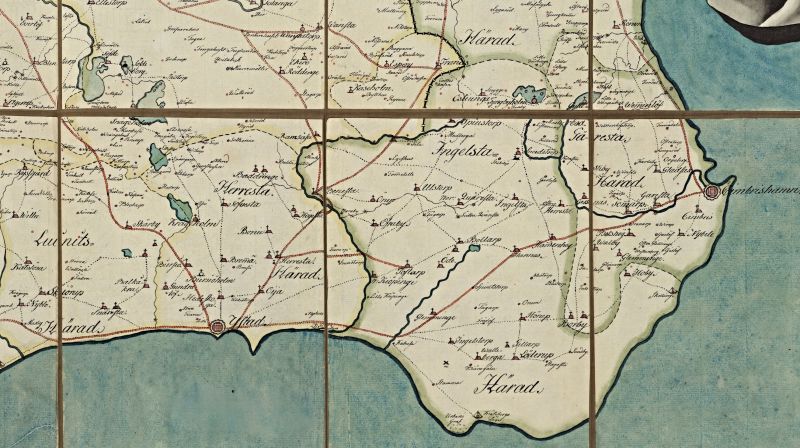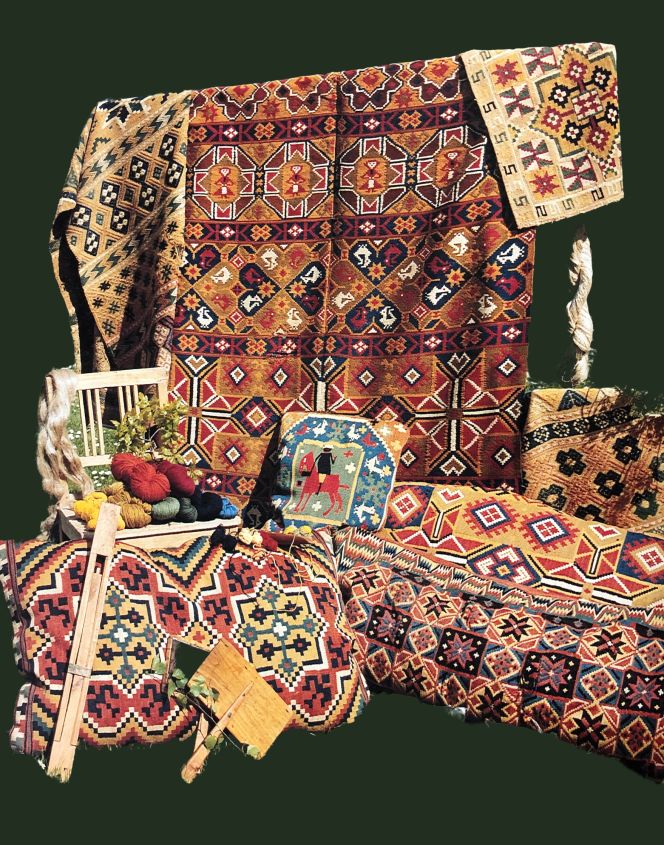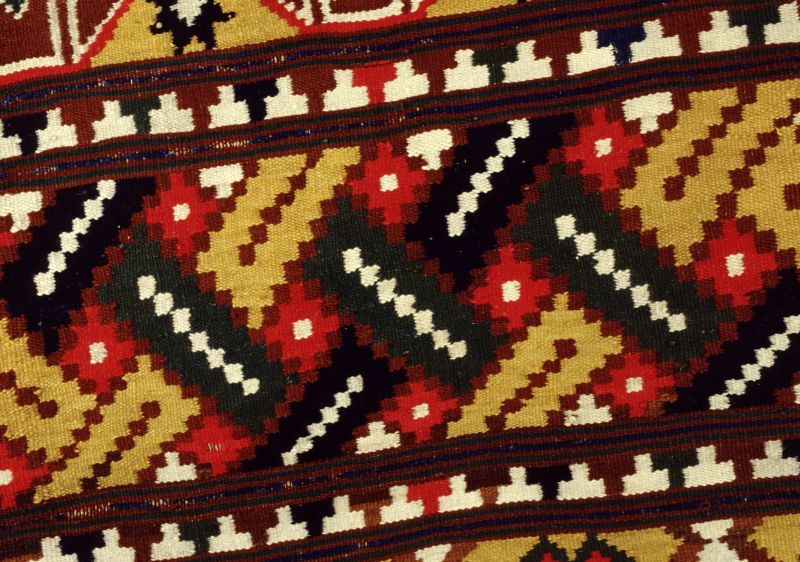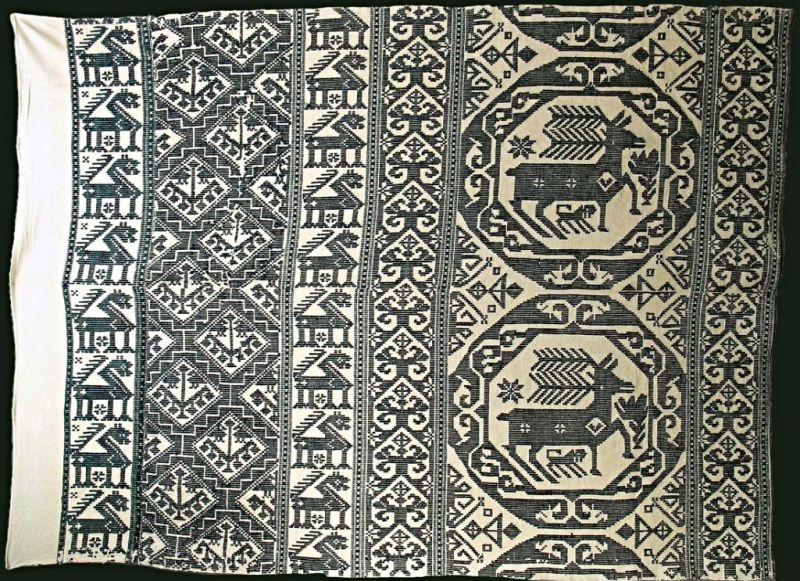ikfoundation.org
The IK Foundation
Promoting Natural & Cultural History
Since 1988


 Crowdfunding Campaign
Crowdfunding Campaignkeep knowledge open, connected, and growing on this textile history resource...
INTERIOR TEXTILES
– Swedish Textile Traditions in Farming Communities: 1760s to 1860s
Contemporary written sources are essential for understanding the frequency of various textile categories in farming communities, particularly via estate inventories, which often give detailed notations. Among other possessions, the interior textile belongings were usually extensive and divided into several headings: bedclothes, bed linen, bench covers, travel cushions or similar descriptions. This essay will look closely into these documents and present a selection in complete translation to exemplify the importance of such textiles. Foremost regarding everyday life, festivities, the young woman’s dowry and why these treasures were produced in significant amounts in the countryside and villages of Skåne, in the southeastern corner of the province. Preserved textiles from the same area, as well as local artwork, mainly originating from the late 18th century to the 1860s, further emphasise the lengthy period of woollen and linen furnishing textiles with almost identical design combinations and practical needs of household management.
 This map section of the eastern corner of Skåne province is contemporary with the discussed estate inventories, as the map had been improved in 1766 by the surveyor Johan Lorens Gillberg. The districts ‘Ingelsta’, ‘Herresta’, Gärresta’, ‘Albo’ and ‘Ljunits’ together with towns and villages are clearly marked – a geographical area where the knowledge of woollen- and linen weaving in a multitude of techniques was highly developed in the well-to-do farming communities. These skills were transferred from mother to daughter over the generations. (Courtesy: Uppsala University Library, Sweden. Alvin-record:98362. Part of the map, from a copy dated 1812. Public Domain).
This map section of the eastern corner of Skåne province is contemporary with the discussed estate inventories, as the map had been improved in 1766 by the surveyor Johan Lorens Gillberg. The districts ‘Ingelsta’, ‘Herresta’, Gärresta’, ‘Albo’ and ‘Ljunits’ together with towns and villages are clearly marked – a geographical area where the knowledge of woollen- and linen weaving in a multitude of techniques was highly developed in the well-to-do farming communities. These skills were transferred from mother to daughter over the generations. (Courtesy: Uppsala University Library, Sweden. Alvin-record:98362. Part of the map, from a copy dated 1812. Public Domain).The information given in these estate inventories from a deceased person could vary greatly, and the recorders were especially assiduous when it concerned the more valuable textiles, like various art-woven colourful woollen techniques, linen for the bed and table, as well as various wall coverings. The less wealthy families and even the poor sometimes had more home textiles than expected, most often mentioned as bedclothes only (but often there were never made estate inventories for the poor). The differences were foremost that striped cushions and feather beds were owned by most people. At the same time, the more affluent homes also included a large amount of bed linen, table linen and decorative textiles. The common characteristic of the “textile abundance” was its higher value and economy from a status point of view.
Judging from the wealth of textiles surviving in the southeastern part of the province, Skåne in Sweden, in some areas, the women must have woven far more than they or even the next generation could ever use. Most of the weaving was done by the farmer’s wife and daughters or female relatives living in the household. There is no evidence that men participated in this craft, apart from in professional organisations such as the linen weavers guild in Malmö, where almost all were men. The farmers’ daughters were taught how to weave early on in life. This was particularly important during the years prior to a young woman’s marriage, as it was traditionally favoured to have an extensive dowry chest, including a rich selection of textiles, which emphasised one’s reputation as a skilful weaver and status in the community. Weaving skills were also considered important qualities in a woman from several perspectives. Foremost, to make provision for home furnishing, covering everything from basic needs to excessive amounts of woven treasures for the household. Additionally, this was a way to increase the family’s prosperity as rölakan bedcovers, striped featherbeds in large numbers, textile wall hangings, linen, etc., had a substantial financial value. Visible in many preserved estate inventories, with each such art woven item and pair of linen sheets listed separately.
At festivities, the textiles adorned the farmers’ interiors in abundance. Additionally, it was preferred to use several carriage cushions on top of each other on the way to church to show off the status of the family. Nevertheless, in everyday life, the homes were relatively sparsely decorated, most commonly of bed linen, feather-beds, sometimes a seat cushion and simple striped bench covers. There could be several festivities and celebrations during the year, but when a wedding took place, this was one of the most important occasions in a family’s life, an event prepared through several years of collecting, weaving and embroidering for the daughter’s dowry. The dowry could consist of woven fabrics, bed linen and embroideries.
 Most of the art woven textiles were stored in chests throughout much of the year, which has helped preserve the colours almost unaltered in many cases up to the present day. The number of textiles in the homes of well-off farmers was also generally large, often necessitating separate rooms for the chests where woven fabrics and other valuable items could be safely kept. Besides being brought out on festive occasions, the textiles also needed to be taken out of the chests to be aired and dusted on fine spring or summer days. It is also worth noting that women in these rural communities during this period evidently produced even more of these textiles than their mothers or grandmothers did in the 1760s. | In illustration: woollen cushions, bed- and bench covers from the first half of the 19th century, all woven in the eastern part of the province of Skåne in southernmost Sweden. (Private Collection in June 1991). Photo. The IK Foundation.
Most of the art woven textiles were stored in chests throughout much of the year, which has helped preserve the colours almost unaltered in many cases up to the present day. The number of textiles in the homes of well-off farmers was also generally large, often necessitating separate rooms for the chests where woven fabrics and other valuable items could be safely kept. Besides being brought out on festive occasions, the textiles also needed to be taken out of the chests to be aired and dusted on fine spring or summer days. It is also worth noting that women in these rural communities during this period evidently produced even more of these textiles than their mothers or grandmothers did in the 1760s. | In illustration: woollen cushions, bed- and bench covers from the first half of the 19th century, all woven in the eastern part of the province of Skåne in southernmost Sweden. (Private Collection in June 1991). Photo. The IK Foundation.A selection of estate inventories, dating between 1760 and 1765, has been translated in full from Swedish to English for this essay. The documents (from the districts of Herrestads, Ingelstads, Ljunits and Albo) exemplify the substantial differences in ownership of linen and woollen furnishing textiles in various country homes. Notice, even if not mentioned in the inventories, all listed featherbeds, mattresses, ‘rölakan’, ‘rosepath’ and a variety of striped cushions, bedcovers or covers were woven on a linen warp with a woollen weft, if not otherwise stated.
Valuations: ‘Daler kopparmynt’ [Daler in copper coins or Rixdollar copper coin] and ‘öre’. For example: 3.16.
Herrestads district
1760, 10 September, the wife Bolla Larsdotter, No. 16 Stora Herrestad
Linen
- 1 pair of linen sheets 5.-
- 1 pair of linen tow sheets 3.16
- 1 length of linen, 15 aln [≈9 metres] 7.16
- 1 pair of linen pillowcases 2.16
- 1 linen tow sheet 1.8
- 1 tablecloth of lozenge twill, 6 1/2 aln [≈4 metres] 6.4
- 1 linen tablecloth 1.8
- 2 poorer quality ditto 2.-
- 3 tablecloths of linen tow 1.16
- 3 ditto 1.16
- 1 striped linen tow tablecloth 1.16
- 1 towel of linen 1.8
- 1 ditto of linen tow -.24
Bedclothes
- 1 blue striped feather bed 14.-
- 1 ditto green and blue striped 6.-
- 1 yellow striped mattress 7.-
- 1 black striped ditto, old 1.16
- 1 green striped ditto, old 1.16
- 1 green and blue striped pillow 2.-
- 2 red and blue striped ditto 3.-
- 1 red striped ditto 1.8
- 2 blue striped linen pillows 1.-
- 1 yellow striped ditto, old -.16
- The widower's bed is valued at 26.-
and consists of one featherbed, two mattresses, two pillows, one bedcover and one pillowcase.
Interior textile furnishing
- 1 linen wall covering with seven stripes 12.16
- 1 ditto, somewhat older, with ten stripes 9.-
- 1 old linen wall-covering, ten stripes 2.-
- 1 travel cushion, rölakan [double interlocked tapestry] 2.16
- 1 ditto 2.-
- 1 ditto 1.24
- 1 ditto 1.-
- 1 seat cushion 1.8
- 1 bench cover, 8 aln long [≈4,8 metres] 5.-
- 1 ditto, in rosepath, 10 aln long [≈6,0 metres] 3.24
- 1 bedcover of rölakan, 8 aln long [≈4,8 metres] 6.-
- 1 ditto of rosepath 2.16
- 1 ditto black striped cover, 16 aln long [≈9.6 metres] 7.-
- 1 ditto, 5 aln [≈3 metres] 2.-
- 1 ditto, 6 aln [≈3,6 metres] 2.8
- 1 ditto, 2 aln [≈1,2 metres] 1.8
- 1 small cushion -.28
Herrestads district
1762, 29 January, the farmer Jöns Månsson, Tranås
Bedclothes and linen
- The widower’s daily bed 16.-
- 1 old blue and green striped featherbed 6.16
- 1 seat cushion cover 1.-
- 1 travel cushion cover 1.16
- 1 cushion -.16
- 1 ditto -.4
- 1 ditto -.3
- 1 cushion for a cradle -.4
- 1 old pillow -.4
- 1 old tablecloth -.12
- 1 ditto -.8
Albo district
1760, 9 January, the farmer Esbjörn Månsson, Rörum
Bedclothes
- 1 large feather bed 7.-
- 1 ditto 6.-
- 1 pillow -.12
- 1 ditto, blue striped -.20
- 1 ditto, in poorer quality -.14
- 1 mattress, blue striped 2.16
- 1 linen sheet 1.16
- 1 ditto 1.-
Ljunits district
1762, 8 February, the farmer tenant Pär Nilsson, Åckersberg House no. 12
Bedclothes – in the widow’s bed
- 1 red and blue striped woollen featherbed 2.-
- 1 black striped woollen mattress 2.-
- 3 blue striped woollen pillows 2.8
- 2 smaller of the same colour 1.-
- 1 ditto, in poorer condition -.6
- 1 linen sheet 1.16
- 1 linen tow sheet -.24
- 1 yellow, brown and blue striped bedcover -.16
Other bedclothes
- 1 linen bedtick, brown striped 1.24
- 1 old blue striped woollen pillow -.16
- 1 ditto, in poorer quality -.6
- 1 brown striped woollen featherbed 4.-
- 1 brown striped linen mattress 2.-
- 1 shaft woven bedcover -.12
- 1 old ditto -.6
- 1 worn bench cover -.24
- 1 travel cushion [dukagång or rölakan technique] -.16
- 1 cushion [dukagång or rölakan technique] -.14
Linen
- 1 linen tow tablecloth with fringes -.12
- 1 smaller ditto -.6
- 1 linen tow towel -.8
- 4 spools of linen tow yarn 1.-
- 2 1/2 spools of scutching tow yarn -.8
Ingelstads district
1765, 11 April, the widow Ingar Kiällsdotter, Glemminge
Bedclothes
- 1 blue striped featherbed 10.-
- 1 black striped mattress 6.-
- 1 ditto, striped 1.16
- 1 blue striped pillow 1.16
- 1 blue striped ditto 1.-
- 1 black striped ditto 1.8
- 1 bench cover in Rosepath technique 1.16
- 1 travel cushion in Rosepath technique 8.-
- 1 travel cushion [dukagång, halvkrabba, krabbasnår] 8.-
- 1 old worn-out linen bedcover 2.-
 Close-up detail of an undated rölakan bench cover, in alternating wide and narrow T-shaped borders. This is an example of the typical design of southeastern Skåne from the late 18th century up to circa 1850. (Collection: Helsingborg Museum, Sweden. NO. 417-40, part of textile). Photo: The IK Foundation, London.
Close-up detail of an undated rölakan bench cover, in alternating wide and narrow T-shaped borders. This is an example of the typical design of southeastern Skåne from the late 18th century up to circa 1850. (Collection: Helsingborg Museum, Sweden. NO. 417-40, part of textile). Photo: The IK Foundation, London.![Cottage interior in Skåne province, with the wooden box bed as a focal point, arranged with several mattresses and an art-woven multi-coloured striped bedcover on the top, whilst white and blue linen/wool bed curtains in woven ‘dukagång’ (the same technique as illustrated in the image below) hung on each side of the bed. Oil on canvas by Jakob Kulle (1838-1898) in the year 1880. This scene of a farming interior, however, was supposed to depict circumstances circa 30-40 years prior to when it was painted, at a time when the long-lived traditions in furnishing, interior textiles and locally styled clothing still were common in many farming communities. This made-up bed may be compared with an estate inventory dated 14 July 1765 after the farmer tenant Hindrich Jönsson, Gyllerup. The home was relatively poor, but listed below the heading ‘Bedclothes’, the most valuable objects in the home were revealed as ‘1 made-up bed with everything included’, valued at 12 ‘Daler kopparmynt’ [Daler in copper coins or Rixdollar copper coin]. Together with two other textile objects only, 1 black striped featherbed worth 3 Daler… and 1 bedcover valued at 4 Daler in copper coins. (Courtesy: Stockholms Auktionsverk, sold in 2015. Unknown ownership).](https://www.ikfoundation.org/uploads/image/4-a-jacob-kulle-1880-800x634.jpg) Cottage interior in Skåne province, with the wooden box bed as a focal point, arranged with several mattresses and an art-woven multi-coloured striped bedcover on the top, whilst white and blue linen/wool bed curtains in woven ‘dukagång’ (the same technique as illustrated in the image below) hung on each side of the bed. Oil on canvas by Jakob Kulle (1838-1898) in the year 1880. This scene of a farming interior, however, was supposed to depict circumstances circa 30-40 years prior to when it was painted, at a time when the long-lived traditions in furnishing, interior textiles and locally styled clothing still were common in many farming communities. This made-up bed may be compared with an estate inventory dated 14 July 1765 after the farmer tenant Hindrich Jönsson, Gyllerup. The home was relatively poor, but listed below the heading ‘Bedclothes’, the most valuable objects in the home were revealed as ‘1 made-up bed with everything included’, valued at 12 ‘Daler kopparmynt’ [Daler in copper coins or Rixdollar copper coin]. Together with two other textile objects only, 1 black striped featherbed worth 3 Daler… and 1 bedcover valued at 4 Daler in copper coins. (Courtesy: Stockholms Auktionsverk, sold in 2015. Unknown ownership).
Cottage interior in Skåne province, with the wooden box bed as a focal point, arranged with several mattresses and an art-woven multi-coloured striped bedcover on the top, whilst white and blue linen/wool bed curtains in woven ‘dukagång’ (the same technique as illustrated in the image below) hung on each side of the bed. Oil on canvas by Jakob Kulle (1838-1898) in the year 1880. This scene of a farming interior, however, was supposed to depict circumstances circa 30-40 years prior to when it was painted, at a time when the long-lived traditions in furnishing, interior textiles and locally styled clothing still were common in many farming communities. This made-up bed may be compared with an estate inventory dated 14 July 1765 after the farmer tenant Hindrich Jönsson, Gyllerup. The home was relatively poor, but listed below the heading ‘Bedclothes’, the most valuable objects in the home were revealed as ‘1 made-up bed with everything included’, valued at 12 ‘Daler kopparmynt’ [Daler in copper coins or Rixdollar copper coin]. Together with two other textile objects only, 1 black striped featherbed worth 3 Daler… and 1 bedcover valued at 4 Daler in copper coins. (Courtesy: Stockholms Auktionsverk, sold in 2015. Unknown ownership). This well-preserved textile (133cm x 187cm) was woven in the Ingelstad district in the southeastern corner of Skåne province. Due to the similarities over time for these ‘dukagång’ wall/ceiling coverings, woven with unbleached or bleached linen (warp and ground weft) and blue woollen ornamentation (weft), it may not be more precisely dated than a hundred-year period from 1750 to 1850. Such comparable wall coverings were repeatedly listed in many estate inventories. For instance, this one, dated 21 June 1760, after the farmer tenant Christer Richardsson in Hagestad village, Ingelstads district. This home owned a substantial number of linen and woollen interior textiles. Among these were listed: ‘1 wall cover, 5 Daler in copper coins’ and one of the same noted as ‘old’, valued at ‘1.28’ only. These two wall decorations were most probably woven in the traditional “dukagång” technique in white and blue on various borders, similar in style to this illustrated example. (Courtesy. The Nordic Museum, Stockholm, Sweden. No: NM.0207058. DigitaltMuseum).
This well-preserved textile (133cm x 187cm) was woven in the Ingelstad district in the southeastern corner of Skåne province. Due to the similarities over time for these ‘dukagång’ wall/ceiling coverings, woven with unbleached or bleached linen (warp and ground weft) and blue woollen ornamentation (weft), it may not be more precisely dated than a hundred-year period from 1750 to 1850. Such comparable wall coverings were repeatedly listed in many estate inventories. For instance, this one, dated 21 June 1760, after the farmer tenant Christer Richardsson in Hagestad village, Ingelstads district. This home owned a substantial number of linen and woollen interior textiles. Among these were listed: ‘1 wall cover, 5 Daler in copper coins’ and one of the same noted as ‘old’, valued at ‘1.28’ only. These two wall decorations were most probably woven in the traditional “dukagång” technique in white and blue on various borders, similar in style to this illustrated example. (Courtesy. The Nordic Museum, Stockholm, Sweden. No: NM.0207058. DigitaltMuseum).In a broader historical context, this conclusion sheds light on the conditions that contributed to the production of these extraordinary numbers of art-woven textiles and fine linen in farming communities in southernmost Sweden. Particularly intensely and increasingly in number in the period from 1750 to 1850. New influences had mainly been spread in the province of Skåne via trade from the Continent over several centuries until these links were broken abruptly in the mid-17th century. The main reason for this interruption was the Roskilde Treaty of 1658, by which the provinces Skåne, Blekinge, Halland and Bohuslän became part of Sweden. The ending of the Thirty Years’ War ten years earlier was another factor. The main trading activity in Sweden was now carried on via Stockholm, and trade and cultural influences took other directions from here. South-west of Sweden, particularly the southernmost province of Skåne, is now cut off. King Karl X’s unreasonably high customs tariffs also had a significant effect, making importing and exporting goods to these former Danish provinces virtually impossible. The result was economic and cultural stagnation. Skåne and its surrounding areas, which earlier had led the field, now had strictly limited access to news. This cessation of outside trading affected all aspects of life, such as preserving customs, pattern designs, and household goods in the countryside. Due to this, much material culture stayed more or less intact and developed into specialisations in pattern designs, etc., in more isolated geographical areas; in some places, such preferred traditional textiles lasted for over two hundred years until the mid-19th century.
Sources:
- Fischer, Ernst, Linvävarämbetet i Malmö och det skånska linneväveriet, Malmö 1959.
- Geijer, Agnes, Hoffman, Marta et al., Nordisk textilteknisk terminologi: förindustriell vävnadsproduktion, Oslo 1974.
- Gillberg, Joh. Lor., Beskrivning över Christianstads Län uti Hertigdömet Skåne, Lund 1767 (Facsimile, Lund 1980).
- Hansen, Viveka, Textila Kuber och Blixtar: Rölakanets Konst- och Kulturhistoria, Christinehof 1992.
- Hansen, Viveka, Textile Squares & Zigzags: The Art and Cultural History of Double Interlocked Tapestries – Rölakan…, London 2019).
- Landsarkivet i Lund (The Regional Archives in Lund), Sweden. | Research of 1760s estate inventories from the districts Albo, Herrestad, Ingelstad and Ljunits in the southeastern province of Skåne.
- Nylén, Anna-Maja, Hemslöjd, Lund 1978.
- Walterstorff, Emelie von, Svenska vävnadstekniker och mönstertyper, Stockholm 1940.
More in Books & Art:
Essays
The iTEXTILIS is a division of The IK Workshop Society – a global and unique forum for all those interested in Natural & Cultural History.
Open Access Essays by Textile Historian Viveka Hansen
Textile historian Viveka Hansen offers a collection of open-access essays, published under Creative Commons licenses and freely available to all. These essays weave together her latest research, previously published monographs, and earlier projects dating back to the late 1980s. Some essays include rare archival material — originally published in other languages — now translated into English for the first time. These texts reveal little-known aspects of textile history, previously accessible mainly to audiences in Northern Europe. Hansen’s work spans a rich range of topics: the global textile trade, material culture, cloth manufacturing, fashion history, natural dyeing techniques, and the fascinating world of early travelling naturalists — notably the “Linnaean network” — all examined through a global historical lens.
Help secure the future of open access at iTEXTILIS essays! Your donation will keep knowledge open, connected, and growing on this textile history resource.
been copied to your clipboard




– a truly European organisation since 1988
Legal issues | Forget me | and much more...
You are welcome to use the information and knowledge from
The IK Workshop Society, as long as you follow a few simple rules.
LEARN MORE & I AGREE







